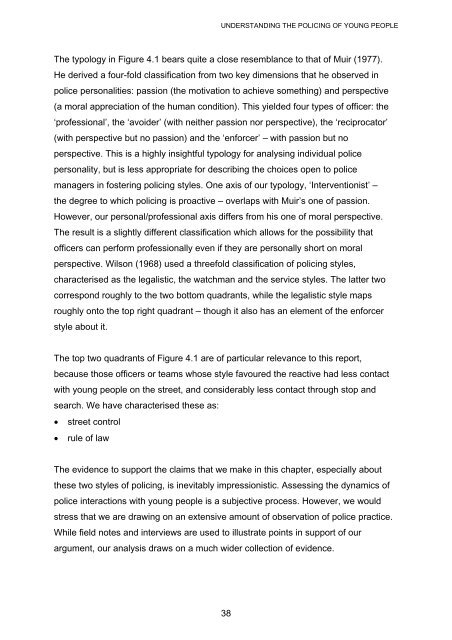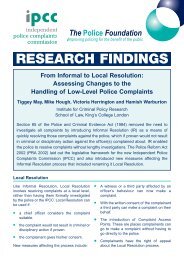Differential treatment in the youth justice system - Equality and ...
Differential treatment in the youth justice system - Equality and ...
Differential treatment in the youth justice system - Equality and ...
Create successful ePaper yourself
Turn your PDF publications into a flip-book with our unique Google optimized e-Paper software.
UNDERSTANDING THE POLICING OF YOUNG PEOPLEThe typology <strong>in</strong> Figure 4.1 bears quite a close resemblance to that of Muir (1977).He derived a four-fold classification from two key dimensions that he observed <strong>in</strong>police personalities: passion (<strong>the</strong> motivation to achieve someth<strong>in</strong>g) <strong>and</strong> perspective(a moral appreciation of <strong>the</strong> human condition). This yielded four types of officer: <strong>the</strong>‘professional’, <strong>the</strong> ‘avoider’ (with nei<strong>the</strong>r passion nor perspective), <strong>the</strong> ‘reciprocator’(with perspective but no passion) <strong>and</strong> <strong>the</strong> ‘enforcer’ – with passion but noperspective. This is a highly <strong>in</strong>sightful typology for analys<strong>in</strong>g <strong>in</strong>dividual policepersonality, but is less appropriate for describ<strong>in</strong>g <strong>the</strong> choices open to policemanagers <strong>in</strong> foster<strong>in</strong>g polic<strong>in</strong>g styles. One axis of our typology, ‘Interventionist’ –<strong>the</strong> degree to which polic<strong>in</strong>g is proactive – overlaps with Muir’s one of passion.However, our personal/professional axis differs from his one of moral perspective.The result is a slightly different classification which allows for <strong>the</strong> possibility thatofficers can perform professionally even if <strong>the</strong>y are personally short on moralperspective. Wilson (1968) used a threefold classification of polic<strong>in</strong>g styles,characterised as <strong>the</strong> legalistic, <strong>the</strong> watchman <strong>and</strong> <strong>the</strong> service styles. The latter twocorrespond roughly to <strong>the</strong> two bottom quadrants, while <strong>the</strong> legalistic style mapsroughly onto <strong>the</strong> top right quadrant – though it also has an element of <strong>the</strong> enforcerstyle about it.The top two quadrants of Figure 4.1 are of particular relevance to this report,because those officers or teams whose style favoured <strong>the</strong> reactive had less contactwith young people on <strong>the</strong> street, <strong>and</strong> considerably less contact through stop <strong>and</strong>search. We have characterised <strong>the</strong>se as:• street control• rule of lawThe evidence to support <strong>the</strong> claims that we make <strong>in</strong> this chapter, especially about<strong>the</strong>se two styles of polic<strong>in</strong>g, is <strong>in</strong>evitably impressionistic. Assess<strong>in</strong>g <strong>the</strong> dynamics ofpolice <strong>in</strong>teractions with young people is a subjective process. However, we wouldstress that we are draw<strong>in</strong>g on an extensive amount of observation of police practice.While field notes <strong>and</strong> <strong>in</strong>terviews are used to illustrate po<strong>in</strong>ts <strong>in</strong> support of ourargument, our analysis draws on a much wider collection of evidence.38






